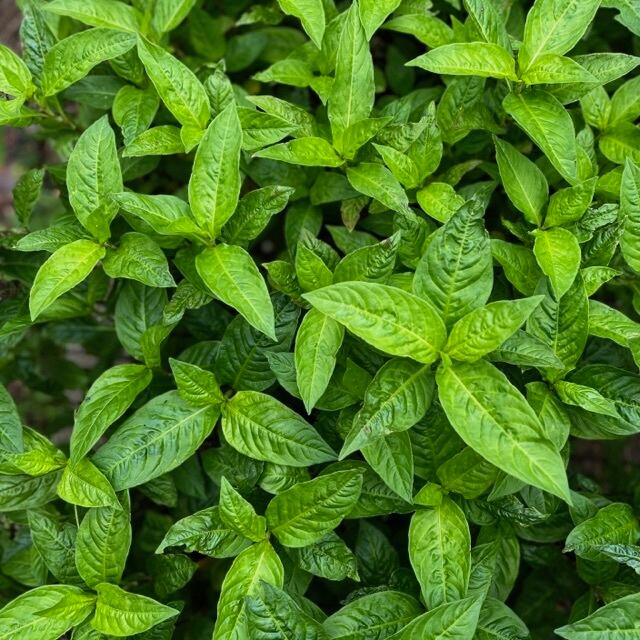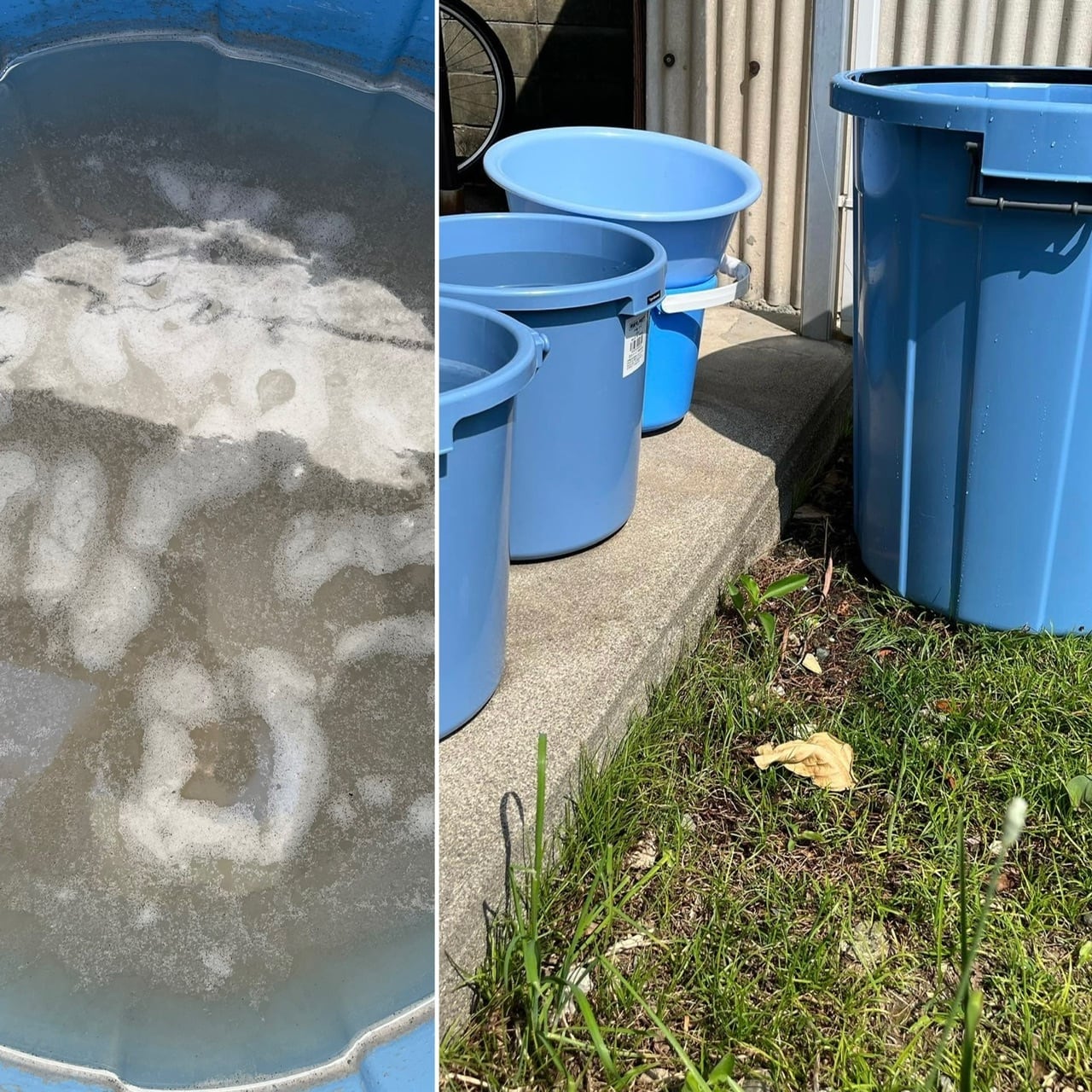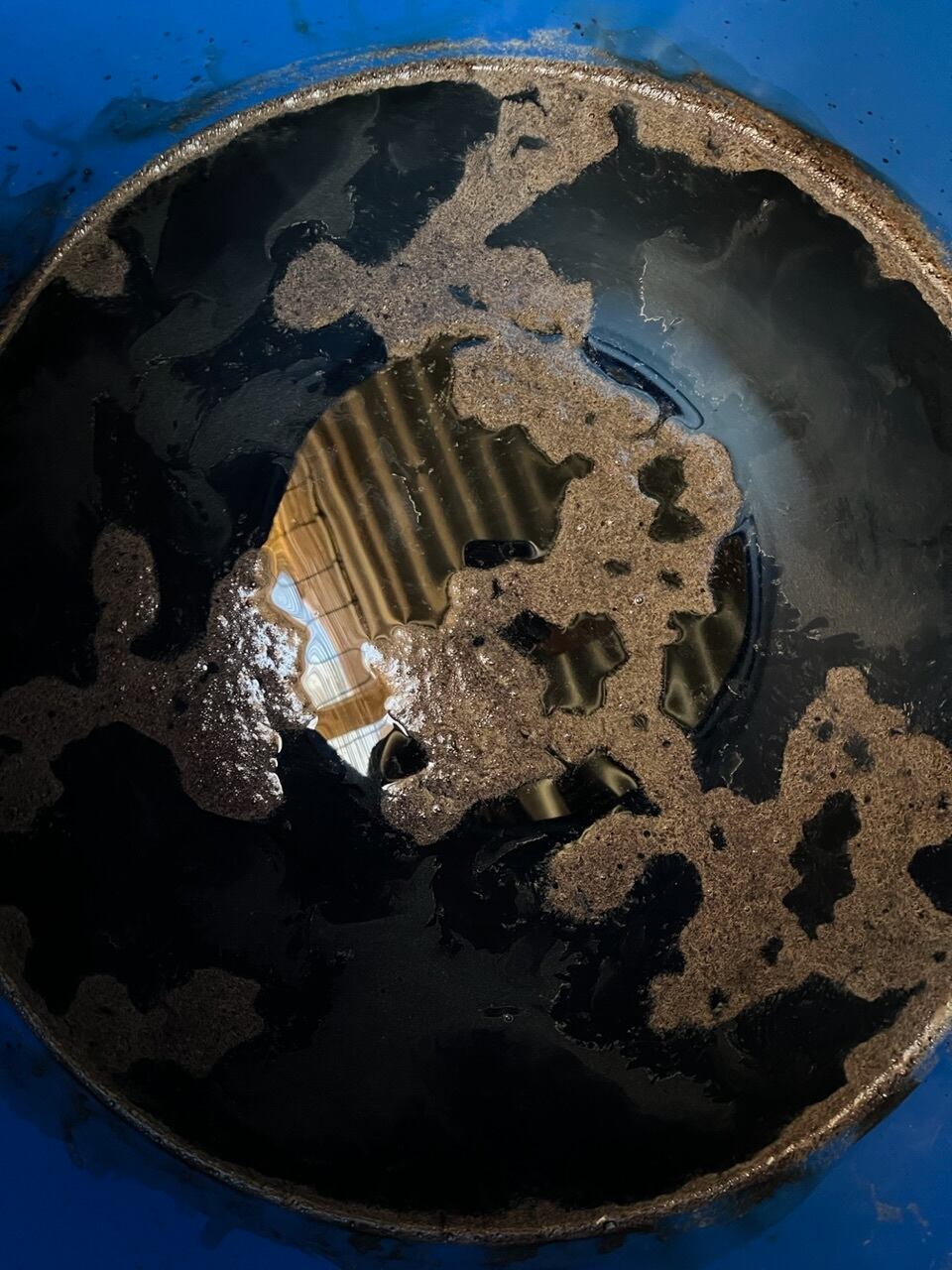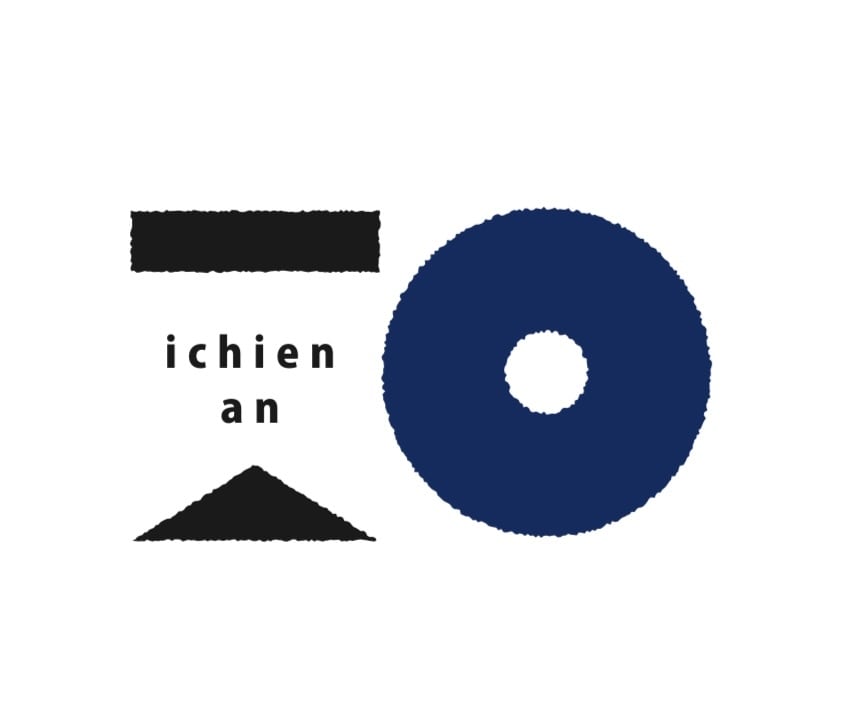天然灰汁醗酵建て
藍染が出来るまで
How indigo dyeing is done
蓼藍 Indigo plant

藍染めの原料となる蓼藍の葉。
藍農家さんの春の種まきから始まります。
一〇庵では、徳島の藍師さんがつくった貴重な蒅を使用し藍染めしています。
Tadeai leaves that are the raw material for indigo dyeing. It starts with the indigo farmer's spring sowing. At Ichi-en-an, we use indigo-dyed materials made by an indigo master in Tokushima.
蒅 Sukumo
藍染をするには、藍の葉だけでは保存もきかず濃く染めることが出来ません。そこで藍の葉を染料の元となる蒅(すくも)にする必要があります。蒅(すくも)は、徳島の藍師さんが夏に収穫した藍の葉を約100日かけて、水を掛けては発酵させ、また乾燥しては水を掛けて醗酵させた蒅藍。とても手間のかかる伝統的な蒅づくりです。
For indigo dyeing, only indigo leaves cannot be preserved and cannot be dyed darkly. Therefore, it is necessary to make indigo leaves into sukumo, the base of the dye. Sukumo is made by fermenting indigo leaves harvested in the summer by an indigo master in Tokushima for about 100 days. It is a very time-consuming and traditional way to make rice cakes.

-丹精込めてつくられた徳島の蒅(すくも)ー
土の固まりのようにも見ます。
蒅(すくも)にすることにより保存が可能です。
生葉とは比べものにならないほどの深い藍色を染めることが出来ます。
- Tokushima's sukumo made with great care -
It looks like a lump of soil. It can be preserved by making it into sukumo. It can be dyed a deep indigo that is incomparable to fresh leaves.
灰汁醗酵建て
工房では化学薬品を使わず自然な方法で藍染めしています。
天然灰汁醗酵建:蒅(すくも)に木を燃やした灰に湯を入れてつくった上澄み液の「灰汁」を用い再発酵させます。このことを藍建て(藍を染まる状態にすること)と言います。発酵させて染色するという世界にもまれな技法です。
At my atelier, we do indigo dyeing in a natural way without using chemicals.
Natural lye fermented fermented: Re-fermented using lye, the supernatant liquid made by adding hot water to the ash from burning wood in sukumo.
This process is called Aidate.
It is a rare technique in the world that ferments and dyes.

藍建の最初の作業は灰汁取りです。藍を建てるには、アルカリPH濃度の高い灰汁が必要です。楢やくぬぎ等、広葉樹の木灰の上澄みを取っていきます。何回も上澄みをとって、別の容器に移していくと最後は透明な灰汁が取れます。この作業だけにも数日かかります。
Aidate's first task is to remove the lye. Lye with a high alkaline PH concentration is required to build indigo. The ash of broad-leaved trees, such as Japanese oak and oak, is skimmed off. If you take the supernatant many times and transfer it to another container, you can finally get a clear lye. This task alone will take several days.

藍建に使用する材料は、蒅、灰汁の他に、有明海の貝灰、菌の調整に小麦のふすまを使用しています。
すべて自然のものから出来ています。
(写真上)貝灰
(写真下)小麦のふすま

蒅(すくも)に灰汁を入れて藍建をしていきます。藍が発酵してくる日数は、季節や温度で変わってきます。調子をみて貝灰や小麦のふすまをいれて発酵の様子を伺います。
Lye is added to the sukumo to Aidate the indigo. The number of days for indigo to ferment varies depending on the season and temperature. Check the condition, add shellfish ash and wheat bran, and check the state of fermentation.

発酵してきた様子。
数日し発酵してくると香りや色が明らかに変わってきます。表面に金紫色の幕が張りその下の液体はこげ茶色です。液体自体は藍色ではありませんが、ひっそりと奥深く潜む藍の色が感じとられます。発酵菌の力で還元要素ができ条件がそろったところで、染めることが可能になります。自然のものなので毎回同じ状態ではありません。発酵が上手く進むか楽しみと緊張が入り混じる時間です。
It looks like it's fermented. After a few days of fermentation, the aroma and color will clearly change. A gold-purple curtain stretches over the surface, and the liquid underneath is dark brown. The liquid itself is not indigo, but you can feel the color of indigo hidden deep inside. The power of fermenting bacteria creates reducing factors, and when the conditions are met, dyeing becomes possible. Since it is a natural product, it is not the same every time. It's time to mix fun and tension to see if the fermentation is going well.
藍染め
ここでやっと藍染めの工程です。アルカリ性の藍液中に布や糸を浸し空気や水にさらし酸化させることで染めることが出来ます。また、一度染めるだけでは色が薄いため、藍液に浸けては引き上げ、空気や水にさらすという工程を何度も繰り返し藍を染め重ねていきます。染めるにも時間がかかる灰汁醗酵建ですが、自然だけが持つ美しい色に染まります。
Here is the indigo dyeing process. It can be dyed by immersing cloth or thread in an alkaline indigo solution and exposing it to air and water to oxidize it. In addition, since the color is light with just one dye, the process of soaking in the indigo solution, pulling it out, and exposing it to air and water is repeated over and over again. Although it takes time to dye it with lye fermentation, it is dyed in beautiful colors that only nature can provide.

染め回数を増すごとに色が濃くなってきます。どのくらいの色のイメージなのか?ご注文の際はお客様とお打ち合わせします。
As the number of dyeing increases, the color becomes darker. How many colors does the image have? We will contact you when you place your order.

-藍染料とのつきあい方-
藍を建てたからといって、それで終了ではありません。藍の染液には微生物がいて生きています。香り、色、その時々で変わってきます。常にいい状態を保つため、毎日藍液の調子を伺います。菌は生き物ですから決して無理をさせません。染める時も大切に取り扱います。一日に沢山染めることが出来ませんし染めたら休ませ毎日染めることも致しません。
How to deal with indigo dye - Even if you use Aidate, it's not the end. Microorganisms live in the indigo dyeing solution. The Scent, the color, it changes from time to time. In order to keep it in good condition, we check the condition of the indigo solution every day. Bacteria are living creatures, so they will never let you overdo it. Handle with care when dyeing. I can't dye a lot in a day, and I don't dye it every day.
天然灰汁醗酵建て・藍染の特長
醗酵菌が染めた後も永く繊維の中で生き続けます。本物の藍の場合、年月と共に、清らかで澄んだ藍色になってきいきます。また色が落ち続けることも、お洗濯の際も他の衣類に色が移ることも有りません。
*昔から人々の生活の中で伝えられた特長
・藍には殺菌・防虫作用がある。
・藍独自の持続性のある芳香は、睡眠作用に効果がある。
・藍の発酵菌により、藍染めの布は丈夫で長持ちである。
日本では野良着やモンペなどに藍染めが用いられ、藍染めの着物をタンスに入れておくと防虫剤が不要であることは知られています。夏は涼しく、冬は暖かいので、寝具や枕に多く使われていました。古代からの装束の中でも、藍染めの衣類は、破損することなく残存していることは、長持ちの証です。
(生きている青「藍の世界」竹田耕三編より)
The fermented bacteria continue to live in the fiber for a long time even after dyeing. In the case of genuine indigo, it will become pure and clear indigo with time. In addition, the color will not continue to fade, and the color will not transfer to other clothing when washing. *Characteristics that have been handed down in people's lives since ancient times ・Indigo has bactericidal and insect repellent effects. ・Indigo's unique long-lasting fragrance is effective for sleep. ・Indigo-dyed cloth is durable and long-lasting due to indigo fermentation bacteria. In Japan, indigo dyeing is used for workwear and monpe, and it is known that if you put indigo-dyed kimono in a closet, you don't need insect repellent. was used. Among the costumes from ancient times, the fact that indigo-dyed clothing has survived without being damaged is proof of its longevity.
(From Living Blue "The World of Indigo" edited by Kozo Takeda)
色のこと color thing

ー藍染・色についてー
藍といっても淡い、濃い、深い、赤みが強いなど、色の濃度も加わりバリエーションは多彩です。藍建したばかりの時は、色素が沢山ありますが染める回数を増すごとに色素は減ります。画像は、建ったばかりの新しい藍と古い藍の組み合わせです。染色による濃淡の過程は、実際に染めてみないとに分かりにくいのですが、簡単に例をあげてみます。水色の透明セロファン5枚、青色の透明セロファン5枚、紺色の透明セロファンが5枚あったとします。水色を5枚重ねても青色ぐらいにしかならない。しかし青色は5枚重ねると紺色くらいになります。紺色を5枚重ねると濃紺です。そして逆に紺色のセロファン1枚で水色にはなりません。それは別色です。藍は絵具と違い、青+白=水色、青の絵具を水で薄めるという訳にはいきません。藍液に染め重ね色を出していきます。色の種類には、時間の経った藍にしかない淡く優しい色だったり、建ちたての強くて勢いのある藍の色だったりさまざまです。その時の表現に必要な色を、藍の色と染め回数で使い分けしています。どの色をどのくらいまで重ねるか?その見極めの足し引きがなかなか難しいのです。なぜなら濡れると色は濃く見え、光を含む乾いた時の色と印象とは異なる為、濃淡の判断がしづらくなります。色を思ったより濃くしてしまったり、反対に薄くしすぎたりということもあります。絞り染めの場合は、生地全体を1色で染める時と違い、糸を解くと模様がだめになってしまう為、染め重ねの色には気を使います。色の判断を誤っても元に戻せません。色を見極める感覚が重要です。
- About indigo dyeing and colors - There are various variations of indigo, such as pale, dark, deep, and strong reddish. When you just Aidate, there is a lot of pigment, but the pigment decreases as you increase the number of times you dye. The image is a combination of the new indigo that was just built and the old indigo. It is difficult to understand the process of shading by dyeing without actually dyeing, but I will give a simple example. Suppose there are 5 clear blue cellophane sheets, 5 clear blue cellophane sheets, and 5 clear navy blue cellophane sheets. Even if you stack 5 layers of light blue, it will only be blue. However, when 5 layers of blue are layered, it becomes dark blue. If you stack 5 layers of navy blue, you get a dark navy blue. And conversely, a sheet of dark blue cellophane will not turn light blue. it's a different color. Unlike paint, indigo is blue + white = light blue, and it is not possible to dilute the blue paint with water. The indigo solution is dyed to create layered colors. There are various types of colors, such as the pale and gentle color that only the indigo that has been used for a long time has, and the strong and vibrant color of the newly built indigo. I use different colors depending on the color of indigo and the number of times of dyeing. How many colors do you layer? It's quite difficult to add and pull the ascertainment. This is because the color looks darker when wet, and it is difficult to judge the shade because it is different from the color when it is dry, including the light. You may end up making the color darker than you thought, or on the contrary, make it too light. In the case of tie-dyeing, unlike when the entire fabric is dyed in one color, if the thread is untied, the pattern will be ruined, so care must be taken with the colors that are dyed in layers. Even if you make a mistake in color judgment, it cannot be undone. The ability to discern color is important.

